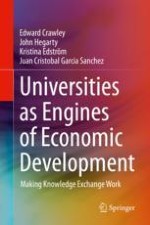2020 | OriginalPaper | Chapter
7. Supporting the Academic Mission of the Adaptable University
Authors : Edward Crawley, John Hegarty, Kristina Edström, Juan Cristobal Garcia Sanchez
Published in: Universities as Engines of Economic Development
Publisher: Springer International Publishing
Activate our intelligent search to find suitable subject content or patents.
Select sections of text to find matching patents with Artificial Intelligence. powered by
Select sections of text to find additional relevant content using AI-assisted search. powered by
Abstract
-
Engaging external stakeholders to understand their needs and inform the curriculum, research, and innovation agendas.
-
Evolving the university culture to be supportive of activities leading to economic development.
-
Revising the university’s mission, strategy, and priorities to focus investment of resources and to communicate how the university will distinguish itself including in innovation.
-
Updating governance procedures to strengthen the role of knowledge exchange and innovation.
-
Recruiting and developing faculty and staff who will strengthen knowledge exchange and engage in the innovation mission.
-
Ensuring that academic facilities are functionally suitable to new learning, innovation, and collaborative research activities.
